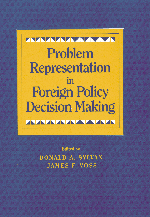Book contents
1 - Introduction
from Part I - Introducing Problem Representation
Published online by Cambridge University Press: 12 October 2018
Summary
To agree on the problems we have with one another is the most important step in negotiations. We haven't yet agreed on problem definition with Syria. We have agreed on problem definition with Jordan. - Aviv Sharon, Director of Public Affairs, Ministry of Foreign Affairs, State of Israel, July 10, 1994
Aviv Sharon has expressed the importance of a critical variable in the understanding and explanation of foreign policy decision making. The manner in which a problem is defined and represented is crucial to the possible solution of that problem.
A great deal of scholarship in the area of foreign policy decision making concentrates on what Sylvan and Thorson (1992) term the option selection stage. Much rational-choice/game-theoretic work carefully illuminates the tradeoffs between alternative courses of action. The subject to be explained is usually the choice between specified options. That is also the subject to be explained by many more traditional, less mathematical studies of foreign policy decision making. In his classic work, Graham Allison (1971) tries to help the reader understand alternative ways of viewing the way in which ExCom (President Kennedy's Executive Committee during the Cuban missile crisis) decided between such specified options as blockade, air strike, and invasion.
“Problem Representation”
What these works do not do is ask the prior question, How did the options get specified in the first place? That is the subject of this volume, and we term it problem representation. How do the game theorist's options and utilities come about? Why were blockade, air strike, and invasion initially chosen as potential options? To answer these questions, we contend that one should understand how the problem to which the options are a response has been represented. One should focus on both the determinants of that representation and its ramifications. This volume explores each of those issues. In the academic community, Pennington and Hastie (1987), Voss, Wolfe, Lawrence, and Engle (1991), and Sylvan and Thorson (1992), have all discussed the importance of problem representation. Pennington and Hastie study jury deliberations and decision making and determine that a “story model” best accounts for the way in which jurors represent the problems they face. Voss defines problem representation in terms of understanding goals and constraints in a particular situation.
- Type
- Chapter
- Information
- Publisher: Cambridge University PressPrint publication year: 1998
- 4
- Cited by



